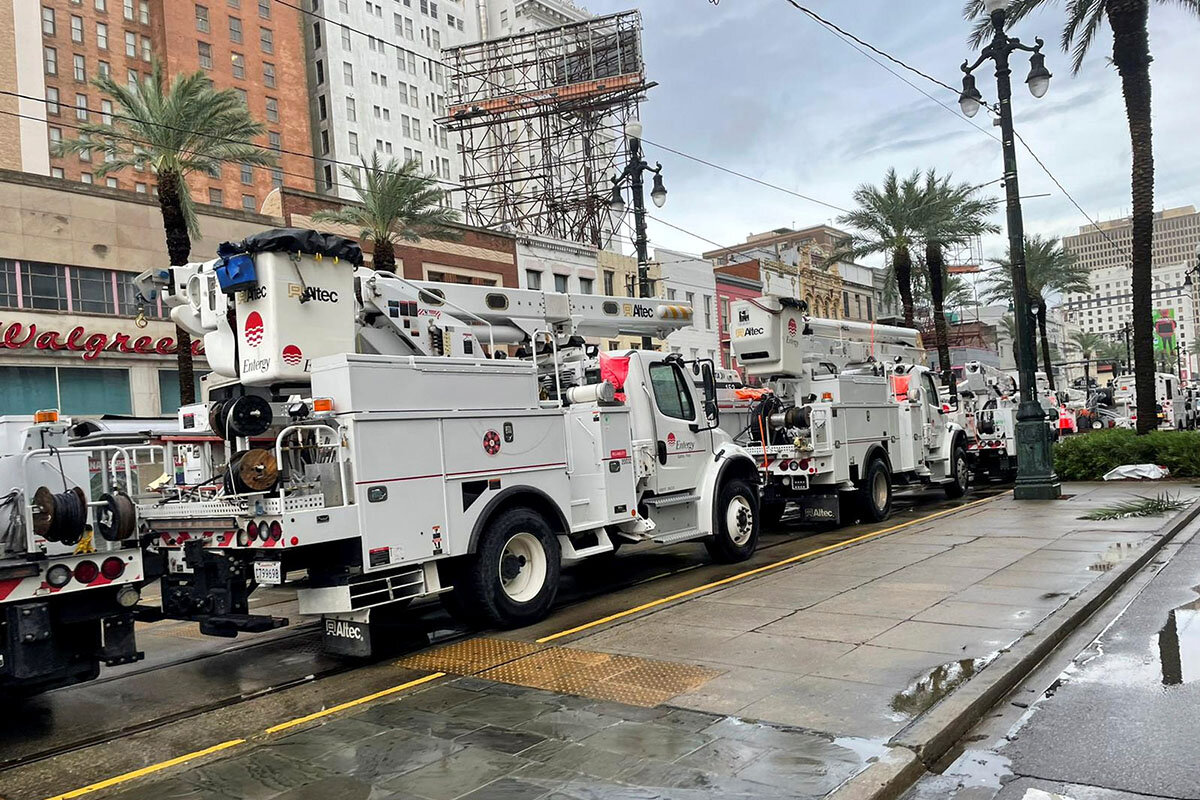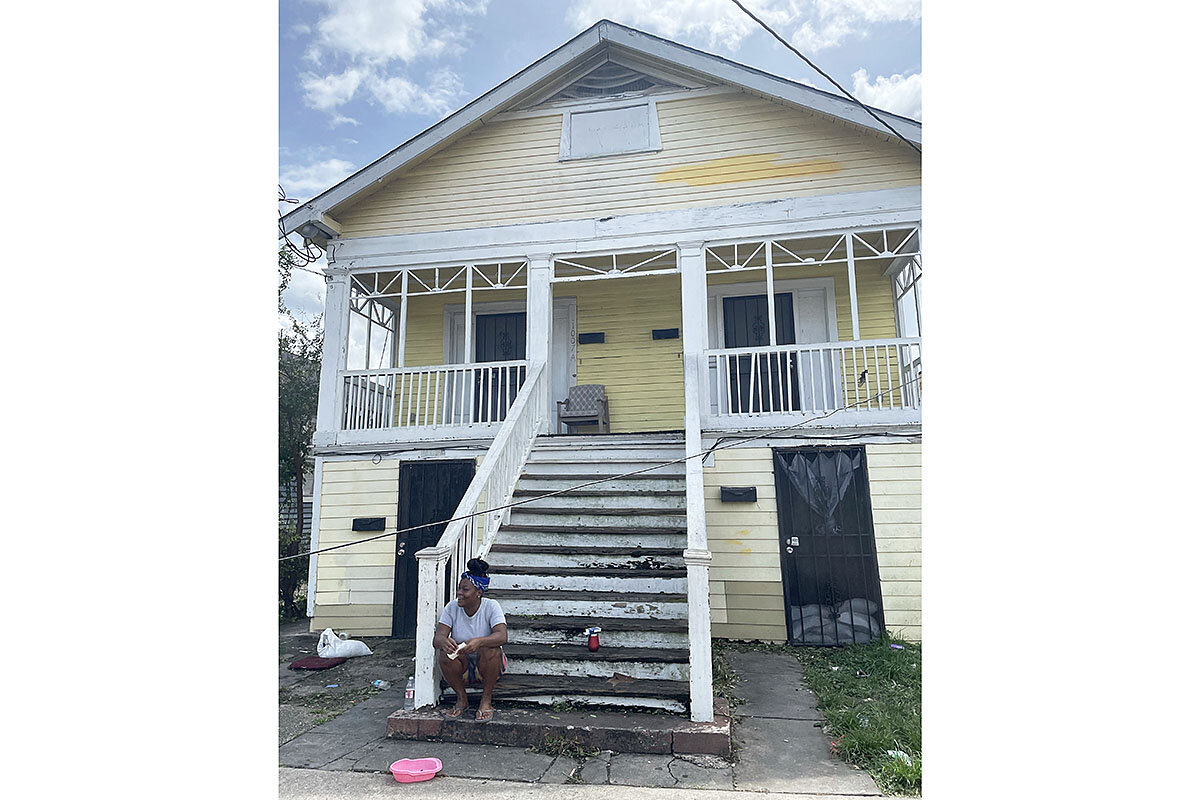After Ida: Power outages, calls for aid ... and sighs of relief
Loading...
| New Orleans
Vast stretches of Louisiana lacked electric power after one of the strongest hurricanes in the nation’s recorded history made landfall Sunday accompanied by major rains as well as winds of 150 mph.
The storm’s surge was so powerful that it reversed the flow of the Mississippi River, but it was not strong enough to break the will of some New Orleans residents.
In particular, residents of the city’s Lower Ninth Ward, which captured national attention as it was swamped by a levee failure following Hurricane Katrina in 2005, were grateful that now-reinforced levees held firm.
Why We Wrote This
Key levees held as Hurricane Ida slammed New Orleans, but now major humanitarian needs have to be met. Although rattled, residents are grateful for progress since Katrina – and are helping one another amid power outages.
The morning after Hurricane Ida swept northward beyond New Orleans, Lower Ninth residents had already begun to band together by picking up debris from their neighbors’ yards. By noon, with news that the electricity in their homes may remain off for days or weeks, residential blocks began planning for barbecues so as not to waste frozen foods.
Many Lower Ninth residents with the resources to do so opted to evacuate in the days prior to Ida’s landfall. They cited the traumatic experience of surviving Katrina as their reason for leaving before Ida.
Among those who stayed was Caleb Law. He says he was confident in his decision until mid-afternoon Sunday rolled around and the storm began to pick up strength. It was around that time he heard the garage attached to the right side of his home begin to peel away under the wind’s strength. It tumbled over his roof until it pierced the side of his neighbor’s home, which stopped the wreckage in its tracks.
“Folks around here are used to this stuff,” Mr. Law says. “I usually sleep through hurricanes, but I got really nervous around 4 o’clock.”
In the daylight on Monday, with the howling winds over, New Orleans and the wider region were only beginning what could be a long recovery. State and federal emergency responders began mobilizing rescue and relief efforts that could last for weeks.
“For the most part, all of our levees performed extremely well – especially the federal levees – but at the end of the day, the storm surge, the rain, the wind all had devastating impacts,” said Louisiana Governor John Bel Edwards on Monday. “We have tremendous damage to homes and to businesses.”
On Monday more than 1 million Louisiana homes and businesses were without electricity.
President Joe Biden issued emergency declarations for Louisiana and Mississippi ahead of the storm to pave the way for relief, and declared a major disaster for Louisiana on Sunday. The Federal Emergency Management Administration (FEMA) has mobilized 3,600 people toward the region to assist in recovery efforts, plus 3.4 million meals and supplies of bottled water for the storm-devastated area.
For many in New Orleans, like Ida Perry and her family, relief can’t come too soon.
During the storm, she felt safe in a French Quarter hotel that the city put some vulnerable residents in for the night – until she didn’t. Ms. Perry remembers watching a roof fly off a nearby building in the French quarter. She could see it from their hotel room window.
“I was so scared,” Ms. Perry says.
Like the rest of the city, the hotel where her family was lost power. Residents were asked to leave the following morning. Many, like Ms. Perry, returned home to find their lives in a state of chaos.
“Everybody had to get out. The only thing you can do is go back home to fend for ourselves,” Ms. Perry says. “Some people ain’t have no house to go back to – their roof is gone.”
Across the city, the Sewerage and Water Board of New Orleans reported outages at sewage pump stations. The board’s officials told residents that the outages put residents at risk of having sewage back up into their homes.
Ms. Perry’s home, which sits at ground level and which took on several inches of water during the storm, was among those to experience a sewage backup.
Darnel Foy, who shares the residence with Ms. Perry, says, “We’ve been trying to get in touch with our landlord, but he isn’t answering the phone. This is what we have to go through.”
Ms. Perry is upset, but she knows her neighbors will be there for her. Many were already gathered around, helping clean up the mess or preparing to barbecue for the block.
But she wonders when longer-term help will arrive, saying “we are stranded.”
“We’ll get you what you need if we can,” President Biden said Monday. “The people of Louisiana and Mississippi are resilient. But it’s in moments like these where we can certainly see the power of government to respond to the needs of the people, if government’s prepared and if they respond.”
By the day’s end the storm’s damage, including at least some deaths, was still in the early stages of being assessed. Ida roared through a region chock-full of energy industry assets like oil refineries and offshore drilling platforms. Much of that infrastructure was shut down in preparation for the storm – but the disruptions were not expected to have immediate effects on supplies of gasoline and other fuels nationwide.
As the rains of Ida moved north and eastward Monday, many residents echoed Ms. Perry’s calls for help.
Suzette Francis is focused on reconnecting with family members in the area – and on obtaining food and water, especially. But after the experience the night before, she is thankful to see the light of the day today.
“I’m just glad I’m alive,” she says.







